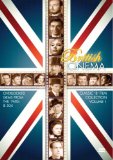| Reviews & Columns |
|
Reviews DVD TV on DVD Blu-ray 4K UHD International DVDs In Theaters Reviews by Studio Video Games Features Collector Series DVDs Easter Egg Database Interviews DVD Talk Radio Feature Articles Columns Anime Talk DVD Savant Horror DVDs The M.O.D. Squad Art House HD Talk Silent DVD
|
DVD Talk Forum |
|
|
| Resources |
|
DVD Price Search Customer Service #'s RCE Info Links |
|
Columns
|
|
|
British Cinema: Classic 'B' Film Coll., Vol. 1 (Tread Softly Stranger, Crimes at the Dark House, Girl in the News, more)
Good show! VCI Entertainment has released British Cinema: Classic 'B' Film Collection, Volume 1, a three-disc, six film collection of some sprightly, fast-paced programmers from Britain's lower-end production companies. Purists will be upset by VCI's use of beat-up syndicated television prints (including a pan-and-scan version of the only widescreen title in this collection), but 'B' movie lovers (hopefully) will just sit back and enjoy the shows - especially when one considers these entertaining but admittedly marginal titles may not come to DVD in any other way than in these compromised transfers. Titles include 1938's Sexton Blake and the Hooded Terror, 1940's Crimes in the Dark House and The Girl in the News, 1952's The Frightened Man, 1958's Tread Softly Stranger, and 1960's The Siege of Sidney Street. There's not a dog in the bunch (another big plus for this kind of collection), with one title, Sir Carol Reed's The Girl in the News, showing flashes of genuine art amid the more meat-and-potatoes offerings in this set. Let's look at the individual titles.
SEXTON BLAKE AND THE HOODED TERROR (aka: THE HOODED TERROR)
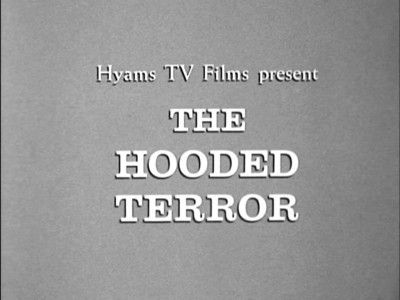
Cool English man of adventure Granite Grant (David Farrar) is in deep trouble in Shanghai. Thugs belonging to the world's most dangerous criminal organization, The Black Quorum, have set upon him, almost killing Grant for what he knows about the shadowy terrorist group. Sending a message to London via his friend Paul Duvall (Bradley Watts), Grant wishes to alert Sexton Blake (George Curzon), London's master detective, of The Black Quorum's activities. But a South American blowgun ends Duvall's life before Blake and his trusty right hand Tinker (Tony Sympson) can decipher Grant's code. Complicating matters is the arrival of Julie (Greta Gynt), a French espionage agent who seems quite interested in multi-millionaire stamp collector Michael Larron (Tod Slaughter). Will Blake and Tinker, with the reluctant aid of stout, doubting London police inspector Bramley (H.B. Hallam), save Julie from the clutches of the mysterious head of The Black Quorum, The Snake?
SPOILERS ALERT!
I've never read any of the variously-authored Sexton Blake mysteries (a Sherlock Holmes knock-off who enjoyed a surprisingly long career - over 80 years - as the star of penny dreadfuls, pocket mysteries, magazines, radio serials, 'B' movies and even his own television series in the 1960s), but I suppose that doesn't matter here, considering Sexton Blake and the Hooded Terror operates much like a lesser Sherlock Holmes story married to a traditional Saturday matinee serial. None of it is original in the slightest, but it's carried off with a bit of verve despite the low, low budget (the casino itself is rather creepy, with its wax-work dummies standing in for real patrons, while the finale's Death Chamber of Serpents is acceptable - if too brief -- horror). As with any kind of 'B' like this, there's quite a bit of exposition to explain events that aren't covered by the budget. And the physical look of the sets can be underwhelming (particularly the rather pathetic casino lair of The Black Quorum). But producer/director George King never lets the film idle, keeping the screenplay by A.R. Rawlinson (who penned the screenplay for the 1940 British version of Gaslight) moving along at a rapid clip.
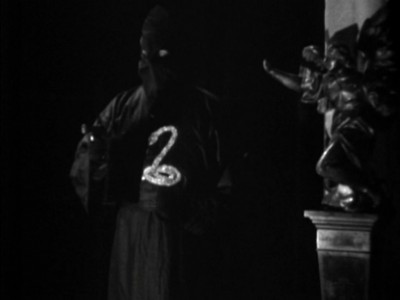
It's a surprisingly funny script, too, with numerous comical asides thrown in to leaven the affair. The Tinker character provides most of the common-man joking in the film (he blows himself up in Blake's lab at one point), but other comic bits are sprinkled throughout the film (I particularly like the waiter who throws up his hands in resignation after giving Blake a message the waiter doesn't understand), keeping events light and amusing. The Blake character will be thoroughly familiar to anyone who has ever watched a Sherlock Holmes film, but he's varied just enough (not at all depressed, a bit of a rake, game for making physical threats) to keep one's interest (at one point, he kicks Tinker in the rear - I'd like to see Holmes do that just once to the phlegmatic Watson). Today, the film probably garners interest solely for the appearance of legendary stage and screen "barnstormer" Tod Slaughter as the head of the criminal organization. Appreciated on the same level as performers like Vincent Price or Bela Lugosi (for his enthusiastic hamming-it-up in low-budget shockers), I didn't find Slaughter exceptionally menacing here (he's much better in his other appearance on this disc, Crimes in the Dark House). But then again, it's difficult to work up much interest in his escapades when the mystery is so obvious (even my kid cracked the longitude/latitude code before Blake) and the details sometimes silly (why do The Black Quorum members keeping wearing and taking off those ridiculous black hoods when they meet? Don't they already know each other already?). Still, Sexton Blake and the Hooded Terror is a perfectly acceptable programmer that doesn't outstay its welcome, and which provides a bit of fun and minor chills in the less-demanding form of the traditional 'B' filler.
CRIMES AT THE DARK HOUSE
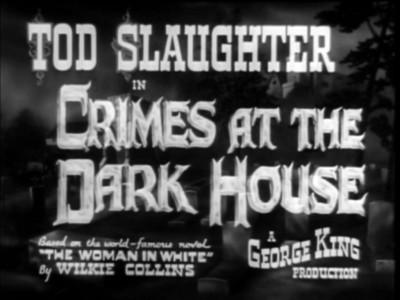
Adapted from the evergreen "sensation novel" The Woman in White by Wilkie Collins, Crimes at the Dark House begins at an Australian gold mine with the horrific murder of the real Sir Percival Glyde by an unknown stranger (Tod Slaughter), who assumes the identity of Sir Percival when he learns that Percy has inherited a vast estate. Returning to England to collect his ill-gotten booty (or his "ill-booten gotty," as Hawkeye would say), the false Percy is in for two shocks: the estate is mortgaged to the hilt, and Lady Catherick (Elsie Wagstaff) comes forward to accuse Percy of fathering her illegitimate child Anne (Sylvia Marriott), who now resides in an insane asylum because of her psychotic hatred of her reprobate father. Lady Catherick, shady Dr. Isidor Fosco (Hay Petrie), and family lawyer Merriman (David Keir) don't believe for a second that Percy is really who he says he is, but that might not matter once Percy marries sweet, innocent Laurie Fairlie (Sylvia Marriott again), who was promised to the real Percy in an earlier marriage contract. She's loaded with dough, and easy on the eyes, too - just what the fake Percy is looking for in a woman (when he's not fooling around with the cheap chambermaid Jessica, played by Rita Grant). But when the mysterious "woman in white" begins appearing in the windows of Percy's estate, all hell breaks loose and the bodies start piling up.
SPOILERS ALERT!
Now I get the appeal of cult favorite Tod Slaughter. The film itself is a crackerjack entry in the bloodthirsty Victorian melodrama genre, with producer/director George King (working from a script by Frederick Hayward, Edward Dryhurst, and H.F. Maltby) once again zeroing in on the exploitation angles that no doubt kept the second-run houses' patrons happily clutching their chair arms. Shot again with lightening speed (it only runs 69 minutes), it's over long before you start to see the cracks in the low-budget production. The minor romantic subplot featuring Marriott and Geoffrey Wardwell as painting tutor Paul Hartwright (his character's name should confirm to you that this is pure, unadulterated melodrama), is a bit of snooze, no doubt exacerbated by Wardwell's ridiculous stiffness (Marriott, though, is quite lovely and charming), but it plays distinct second-fiddle to Slaughter's outrageously broad portrayal of the murderous Sir Percival Gylde - and thank goodness for that
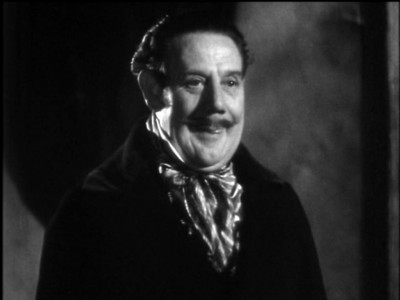
Slaughter, a legendary figure in the English theatre who "barnstormed" his way through the English theatrical circuit for five decades, was primarily associated with the Victorian "blood and thunder" melodramas that proved popular year after year with provincial audiences looking for sensational, exploitation thrills. Most successful at playing a villain (his signature roles included Sweeney Todd and the marvelous British urban legend, Spring-Heeled Jack), Slaughter really gets a workout here in Crimes at the Dark House. He's basically the whole show, and I haven't seen this enjoyably a hammy performance in quite some time. Looking as if he's still playing to the back stalls, Slaughter refuses to tone down his melodramatic arm flourishes (watch him pantomime palming Jessica's rear as she walks away from him - hilarious), Slaughter can barely contain himself as the oversexed, psychotic murderer Percival. Literally licking his lips and brushing his moustache in the best Simon Legree fashion, Slaughter indulges in his trademark snickering chortle at the drop of the hat, bumping off people left and right as he practically begs the audience to laugh at him/laugh with him/fear him. It's a remarkably affected, hammy performance, and one supremely confident in its goals to broadly enthrall. He's no Olivier, to be sure, but he's damned entertaining.
THE GIRL IN THE NEWS
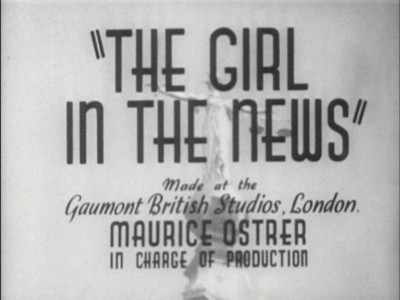
Lovely private nurse Anne Graham is on trial for murder. Her patient, Miss Blaker (Irene Handl), a petulant, vindictive, insecure woman confined to her bed, initially set-up Anne for theft (stowing away some items in her valise) when Anne refused to work for her anymore. Relinquishing her threat to leave, Anne leaves the needy, whining Miss Blaker alone for a moment - which is long enough for the invalid to miraculously get out of bed and take an accidental overdose of sleeping pills. Found innocent at her trial with the help of defense attorney Stephen Farrington (Barry K. Barnes), Anne finds it impossible to get a job when people still suspect her of murder. It doesn't help, either, that her own lawyer is still suspicious of her innocence. Following a mysterious, anonymous lead for a job opening with a kindly, wheelchair-bound millionaire Edward Bentley (Wyndham Goldie), Anne soon finds herself involved in more intrigue as butler Tracy (Emlyn Williams) and Bentley's wife Judith (Margaretta Scott) resent her growing closeness to Edward. Or do they?
SPOILERS ALERT!
Certainly the best offering here in the British Cinema: Classic 'B' Film Collection, Volume 1 set, The Girl in the News offers not only a tight, lean mystery like the other films here, but also flashes of real cinematic style, courtesy of director Carol Reed. The story itself is a fairly layered mystery (with a screenplay by expert scenarist Sidney Gilliat, based on the novel by Roy Vickers) which actually has something to say about its characters outside the conventions of its plot structure (a real rarity with exploitation 'B' programmers). Anne's anguish over events she couldn't control mesh with Stephen's suspicions of her real intentions to make an intriguing subtext concerning guilt by innuendo and association. The Girl in the News's script gives the audience something outside mere plot points to hang their interest on, rewarding the viewer with a resonant story that isn't dependent on the enjoyable yet formulaic thrills of this set's other titles.
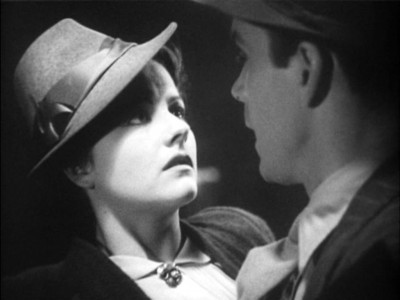
As well, the director, Carol Reed (Odd Man Out, The Fallen Idol, The Third Man, Our Man in Havana, Oliver!) successfully infuses The Girl in the News with not only a foreboding Hitchcockian atmosphere of dread and fatality (a luxury in fast-moving, basic chillers), but also a handful of artful cinematic tricks that one almost never sees in your average 'B' programmer. Nice little directorial touches are scattered throughout The Girl in the News, touches that most programmer directors didn't have the budget, time, or frankly, talent, to work out and include in their tight, rigid productions. When Miss Blaker (in an effectively repulsive performance by Irene Handl) gets out of bed to take the sleeping pills she so desperately craves (and which have been forbidden by Anne), Reed has her little bedmate, a small, black kitten, playful tug at her frayed nightgown hem - creating not only added suspense (will she stop to admonish the kitty and thus be discovered by Anne?), but also providing a perverse inverse take on the old "while the cat's away..." saying. With Anne safely employed with a new identity, she finds she can't escape her past when, caught in a traffic jam, she spots Stephen on the sidewalk. Reed has some fun with the audience's tension on whether or not she can successfully hide from Stephen (in a scene very reminiscent of Hitchcock). Stephen's roommate, Bill Mather (Roger Livesey), who just happens to be a police detective, has a nice Hitchcockian moment where he retraces Anne's movements...right back to his own apartment (where she met Stephen the night before). And fellow murder accomplice Tracy (Emlyn Williams) has his face distorted and reflected in a silver plate he's polishing - which later shines a light on his face when the police pass him, discussing who might have murdered Bentley. The film's climax - the oft-used blind witness fake-out - is crisply and neatly turned out by Reed; compare his handling of it with the director of Tread Softly Stranger, included on this set, who also utilizes that hoary old mystery cliche.
THE FRIGHTENED MAN
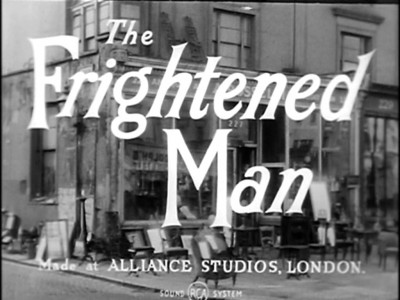
At a second-hand antique shop in a London suburb, Roselli (Charles Victor) anticipates the arrival of his son Julius (Dermot Walsh), who is enjoying a break from his architecture studies at Oxford College. Roselli's assistant, the prissy Cornelius (Michael Ward), isn't too sure of Julius, nor is "Corny" happy with Julius' associate in antiquing, Alex (Martin Benson), a shady character who recently sold Roselli a pair of stolen Ming vases. When Julius does return home, it's not an especially happy occasion. He tells his father he's been "sent down" (kicked out) from Oxford, and that he has no plans on going in with him on his "junk" shop. Julius is obviously embarrassed by his immigrant father, and treats him abominably; he even steals 50 pounds from his father's secret stash to buy a car. Which seems to impress Amanda (Barbara Murray), a lodger staying with Roselli who was going with Harry (John Horsley), a cultured, kind lodger also sharing digs at Roselli's. Julius' petty theft doesn't stop with stealing his father's money; soon, he's cavorting with known shady crook Maxie (John Blythe), who involves Julius in an armed stickup - a descent down a criminal path that will end in tragedy for all concerned.
SPOILERS ALERT!
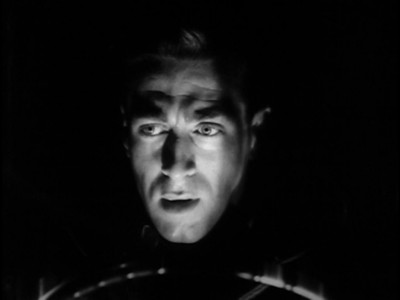
A thoroughly familiar but solid, unpretentious little crime meller/film noir, The Frightened Man is notable (at least in this set) for the increased use of real locations. The previous offerings relied on studio mock-ups almost exclusively, but in The Frightened Man, the viewer gets to breathe a little of that London air as writer/director John Gilling goes outside to get some gritty urban shots. Influenced perhaps by the recent influx of American film noirs, as well as European neo-realism imports, both of which stressed naturalistic location shooting, British crime thrillers from this period increasingly moved outdoors to open up their sordid little tales of deception and betrayal. Directed with a sure hand by veteran John Gilling (The Reptile, The Mummy's Shroud, The Saint), and backed up by legendary 'B' producers Monty Berman's and Robert S. Baker's Tempean Films, The Frightened Man may hold no surprises, either in plot or in character motivation, but it doesn't take the audience for granted, either, working over its familiar plot with an admirably straight face.
TREAD SOFTLY STRANGER
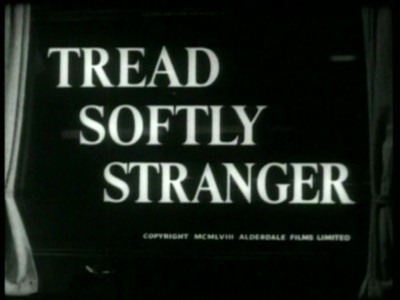
Which can't be said for this hysterically-pitched 'B' programmer. Sharpie Johnny Mansell (George Baker), all primed in his killer bachelor flat for another conquest, beats a hasty retreat from his babe when he gets a call from his bookie requesting his owed money...or else. Returning home to Rawborough, a bleak, sooty industrial wasteland, Johnny reconnects with his bookish brother Dave (Terence Morgan) who works as a bookkeeper at the local steel foundry. Johnny also gets acquainted with Dave's next-door neighbor and would-be girlfriend Calico (Diana Dors), a blonde bombshell with legs for days and cleavage...for days. An insatiably horny gold-digger, Calico has latched onto Dave because he's a non-threatening dope who blows money on her, but once she gets a load of dangerous Johnny, she puts out like there's no tomorrow. Unfortunately for both brothers, Johnny learns that Dave got all that dough by embezzling from the foundry - and he only has a week to get the money back before auditors are due to check the books. Naturally, Johnny gets involved, and events quickly spiral out of control.
SPOILERS ALERT!
Probably of interest today strictly for the inclusion of British bombshell Diana Dors, Tread Softly Stranger is certainly the funniest film in the British Cinema: Classic 'B' Film Collection, Volume 1 set - and that's entirely unintentional, I'm sure. That's not to say Tread Softly Stranger isn't entertaining; on the contrary, it's delicious fun because it's so awful. The love triangle between two brothers - one bad, one worse - and a money-hungry tramp is as old as the hills, so no one is going to be surprised where Tread Softly Stranger winds up. What's amusing about the film is the apparent straight face that everyone managed to put on - despite the ridiculous situations and dialogue.
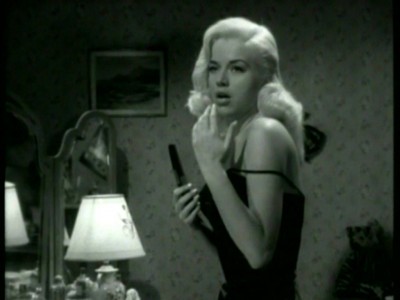
George Baker, an excellent second lead you'll no doubt recognize from British films and television from that period, is all wrong for the part of hot-shot gambler Johnny. Trying to act both tough and flippant, Baker frequently tosses off these off-kilter smirks and mugs that are supposed to, I assume, make Johnny appear roguish, but which actually achieve the effect of making Johnny appear addle-pated (watch him check himself out in a mirror, combing his hair with a flourish that's giggle-inducing). Disastrously, in the film final scene, Johnny is supposed to react with fiendish, ironic, grim humor, laughing at the twist of fate that has befallen him (the old blind witness-trips-up-the-thieves gag), but Baker instead manages to convey not humorous existential justice, but forced lunacy - like a drunk laughing too loudly at his own bad joke.
The rest of the cast is competent (the always enjoyable Patrick Allen has a nice supporting bit as the good-natured Paddy, who begins to suspect the brothers of murder), and despite the flaws in the transfer here, you can tell the film looked great when released, with cinematographer Douglas Slocombe capturing the gritty, gray-skied industrial wasteland of Northern England perfectly. But too much of Tread Softly Stranger is ridiculously overheated - no doubt due to Dors' presence - leaving one to sit back and observe the characters with amusement, rather than with sympathy or suspense. Dors, modeled throughout her career as Britain's answer to Marilyn Monroe, can clearly act; it's just a shame that director Gordon Parry has her enacting a roll call of various Monroe shtick (the pouting mouth, the over-the-shoulder looks of lust) that come off as pale, unflattering imitation. In the moments where she flashes tough, she reminded me of Jane Russell, rather than Monroe, but mostly she's asked to seethe and writhe in passionate heat, which she overdoes to the hilt. Director Parry gives her a memorably kitschy intro shot (bent over in too-small shorts, doing her exercises), but he then proceeds to let her become the living embodiment of a dirty joke - not a character.
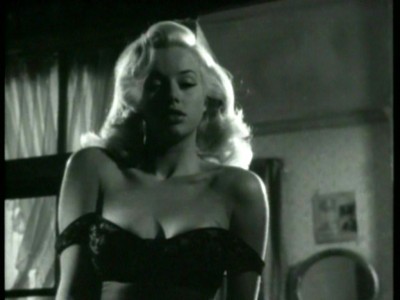
It doesn't help the film's drama chops, either, when the filmmakers indulge in some funny, obvious Freudian editing. During a particularly hilarious scene, Johnny goes out on his grimy terrace, where Dors is stretching and clawing at the moon like a cat in heat. With Johnny looking like he just received a hammer-blow to the head (I don't blame him), and Calico pouting like mad, the film then jumps to various shots of molten iron exploding and sparking at the foundry. Later, when Johnny finally pushes Calico too far, and she attacks him, he kisses her passionately (which she naturally, in this kind of film, responds to), with the filmmakers cutting to a shot of a massive phallic piston being inserted a vat of molten iron, with an orgasmic flow of the smelt spilling all over the floor. That kind of obviousness, married to the overblown, misdirected acting, makes Tread Softly Stranger totally worthless serious drama, but highly entertaining junk.
THE SIEGE OF SYDNEY STREET
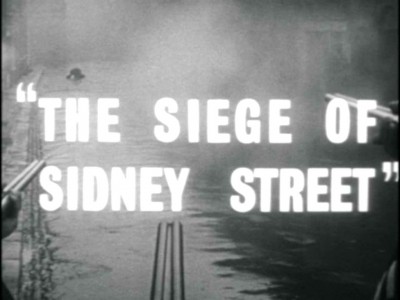
Based loosely on the true events of January 2, 1911 ("The Battle of Stepney"), The Siege of Sydney Street recounts the untold story of Latvian revolutionaries who, living as expatriates in London, form a robbery gang with the intention of funding their political activity. Peter (Peter Wyndgarde), the leader of the group, falls for Sara (Nicole Berger), a newly arrived refugee from the murderous pogroms of Russia. This relationship causes trouble within the group; specifically with Toska (Kieron Moore), a violent, amoral thief who wants Sara for himself. After the gang poorly executes a bank robbery (with two of their members dead), the gang decides to break into a jewelry store safe through the wall of an adjoining office. But the police are tipped off to the operation, and soon the thieves are on the run. The deaths of several police officers lead to a standoff on Sydney Street, with hundreds of police offers battling the holed-up thieves.
SPOILERS ALERT!
Accurately assessing The Siege on Sydney Street is made most difficult by the technical limitations of the transfer here; specifically, it's a pan-and-scanned TV print of the widescreen film (originally filmed in 2.35:1 Dyaliscope). Thus, action is redirected almost constantly, with characters either cut out of the frame from entire sequences, or popping up in inadvertent "jump cuts" from the scanning process. This compromised transfer seriously impacts the film (most definitely to the negative), so consideration of its dramatic worth necessarily take a back seat.
Still, it's hard to imagine that The Siege on Sydney Street was entirely successful as anything other than a standard crime actioner. While most films dealing with historic events take liberties with the facts, The Siege on Sydney Street presents very little facts to begin with, to the point that anyone not already familiar with the actual event might wonder what, exactly, is going on. If the film eventually does get around to telling the viewer what the revolutionaries' ultimate purpose is, I don't remember it. Certainly that stage isn't set at the beginning of the film (they don't even correctly label the gang as Latvians - just "Russians"), nor is enough info (if any) given about what the gang plans on doing with their money, who they're helping, and why they feel the need to steal. And very little character motivation is given for how they feel about being thieves, either. In short, we wind up not caring one way or the other for these criminals, because we don't know what the hell they're really up to here.
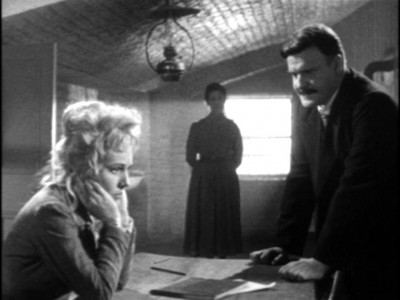
As for the action elements of the film, they's decently handled - if infrequently (there's a cool knife fight between Moore and undercover police agent Mannering, played with cool detachment by Donald Sinden). The final siege doesn't convey the scope of the actual police standoff, but that can be chalked up most probably to the film's limited budget. Unfortunately, too much of the film is exposition, but exposition that doesn't cover what should be important in the film. Quite a bit of The Siege on Sydney Street is taken up by the romance between Sara and Peter (played with remarkable quiet by the usually animated Wyndgarde), but it's a relatively stale affair. Neither dramatically or thematically fleshed out enough, nor particularly rousing in its action sequences, The Siege on Sydney Street is interesting enough, but ironically (considering it probably had the biggest budget of all the films in this set), it's the least successful in terms of delivering a unified cinematic experience.
The DVD:
The Video:
This will be the section that purists will no doubt dislike - and with good reason. VCI Entertainment hasn't spent a dime cleaning these prints up, nor would there be much point, since most of them appear to be TV syndication prints. I have no idea what, if any, cuts may have been made to the films. The prints themselves vary greatly in quality, mostly in the fair-to-good quality - for these types of films. I, just like other movie fans, would like releasing companies to release beautifully silky, pristine prints of every title available, digitally cleaned up and offered up on sparkling, bit-heavy transfers. But that's not reality. It's likely that small, marginal films like these won't ever get that kind of treatment, simply because a company can't make any money with such a proposition. The outlay would far exceed sales. That's not to say that better prints for these titles aren't out there, and that a releasing company with more money and more interest in presenting pristine prints won't surface. But for me, VCI, despite the sometimes iffy quality of the prints here, should be given credit for putting out these obscure titles in the first place. They don't look any worse than when they showed up on TV decades ago (if they ever did here in the States), and I seriously doubt anyone is going to schedule them any time soon on cable. Scratches (sometimes big), screen anomalies, film shrinkage, rough splices, and even some fuzz and hair show up in that projector gate, but again, the prints are surprisingly clean considering that nobody probably thought these films had any reason to still exist seventy years later.
The Audio:
Audio quality (English Dolby Digital mono) is variable, as well, with plenty of warbling and hiss associated with these types of transfers. If you're used to this from previous exposure, you won't mind. No subtitles or close-captions doesn't help, though, VCI.
The Extras:
Each of the three discs includes two vintage trailers for other films. They are: Taming of Dorothy and No Orchids for Miss Blandish on disc one; Bachelor in Paris and Papaer Gallows on disc two; and The Frightened Bride and The Third Man on disc three. There's also an animated photo gallery on disc one, that features some stills and posters from The Siege on Sydney Street.
Final Thoughts:
I love the clean, crisp, razor-sharp look of digitally remastered, anamorphically enhanced, widescreen movies on my big monitor. Who doesn't? But I also profess a nostalgic fondness for the way I viewed films when I was a kid: on crappy, small TVs, with ghostly black and white images coming through the scratches, the splices, and the high contrast. On that very specific, narrow level, British Cinema: Classic 'B' Film Collection, Volume 1 works just fine. The films offered here are good examples of tight, concise 'B' filmmaking, and they move, fella. It's a pity better prints weren't found, but we may be lucky just to have these obscure titles in any condition. Good show. I recommend the British Cinema: Classic 'B' Film Collection, Volume 1.
Paul Mavis is an internationally published film and television historian, a member of the Online Film Critics Society, and the author of The Espionage Filmography.


|
| Popular Reviews |
| Sponsored Links |
|
|
| Sponsored Links |
|
|
| Release List | Reviews | Shop | Newsletter | Forum | DVD Giveaways | Blu-Ray | Advertise |
|
Copyright 2024 DVDTalk.com All Rights Reserved. Legal Info, Privacy Policy, Terms of Use,
Manage Preferences,
Your Privacy Choices | |||||||









